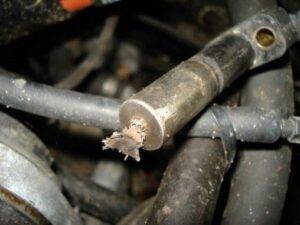
The most important sensors, in any engine, are the crankshaft and camshaft position sensors.
Modern computer controlled vehicles, must have the air and fuel ignited, at the proper time, in order to operate efficiently.
Both, the crankshaft and camshaft (CKP) (CMP) position sensors, are part of your car’s, electronic fuel injection and ignition system.
So, position sensors, are here to stay and are constantly evolving, to meet today’s needs. In the old days, if you had fuel, spark and were close to correct in timing, your engine would run. Consequently, problems in these purely mechanical systems, were relatively easy to diagnose. The difference today is, that a variety of engine parameters, must be controlled to ensure, highly efficient combustion.
Sensors that monitor the crankshaft and camshafts position, must all be working properly. If not, the engine may run poorly or not at all.
So, a failure of the crankshaft or camshaft sensor, can cause a number of issues. Although the engine is mechanically sound, it may have no way of knowing, when the spark plugs should fire.
Crankshaft Position Sensors (CKP)
So, the (CKP) sensor is considered, a multifunctional sensor. And, is used to set ignition timing, detect engine (RPM) and relative engine speed. As a result, this sensor voids the need for, manual distributor timing.

This sensor goes by different names, reliant on the company:
- Crankshaft angle sensor.
- (CKS) sensor.
- (CKP) sensor.
- Crankshaft position sensor.
But, they all perform the same function.
The (CKP) sensor, provides an electrical signal to the (ECM). Indicating the exact location, of the crankshaft.
Camshaft Position Sensors (CMP)
So, the (CMP) sensor, is used to determine, which cylinder is firing. And, then synchronizes, the fuel injector and coil firing sequence.

So, (CMP) sensors, are located along or at, the front of the camshaft. Their job is, monitoring the rotations that camshafts make, to open the intake and exhaust valves. Also, this allows communication, between the ignition system and the vehicle computer.
But, There Are A Few Things, That Can Cause These Sensors To Fail:
- The Environment.
- Dirt And Debris.
- Faulty Wiring.
So, even for modern electronics, the engine is still, a destructive environment. Although built for this, most position sensors, will eventually fail. Anything from, tiny fluctuations in thermal expansion, or vibrations themselves. Consequently, any of these can weaken and break, the internal wiring and circuits in sensors. Bent, broken or worn reluctor ring teeth, can generate, a weak or unstable signal.

Also, along the same lines, damaged metal parts can create debris, in the form of metal filings or shavings. Then, the magnetic crankshaft position sensors, can pick up this debris. The (CKP) sensor works at a certain distance, accounting for the air gap from the reluctor ring. But, captured metal shavings, extend the magnetic field, closing the gap and leading to poor signal generation.
Finally, faulty circuits can cause (CKP) (CMP) sensor failures. Also, if the wires, between the (ECM) and the sensors are damaged. Then, the (ECM) can’t recognize the signal. So, any time you’re investigating sensor issues, it’s critical to verify the circuit first.
Signs That These (CKP) (CMP) Sensors May Be Failing Include:
Drop In Fuel Efficiency
- When the (CKP) (CMP) sensor isn’t working properly, it’ll have a negative impact on fuel economy. You may notice you’re making, more trips to the pump. Especially, if your driving habits remain constant. As long as all other factors about your vehicle are unchanged, this sensor may very well be the culprit.
Poor Acceleration
- Before the (CKP) (CMP) sensor fails completely, you may notice, some hesitation while accelerating. Here, the sensor isn’t sending the correct information, to your car’s computer. Which, in turn, won’t accurately synchronize the engine’s pistons. So, expect your vehicle to have trouble, maintaining its speed with a faulty sensor.
Engine Misfiring And Stalling
- So, a faulty sensor will cause your engine to misfire, as incorrect fuel injection readings weigh in. When this problem becomes especially apparent, the engine may stall and have trouble restarting. Rough idling and backfiring, are two more indicators that something is wrong. So, if the engine fails to start, the position sensors are likely worn out.
Check Engine Light

When the check engine light (CEL) glows, that’s always a sign of a problem. Consider it an added warning, that the (CKP) (CMP) sensor is failing, especially when coupled with:
- A drop, in fuel efficiency.
- Poor acceleration.
- Engine misfiring or stalling.
A engine light diagnostic tool, can find the problem, helping you to take the appropriate action.
For More Information On, Position Sensors Check Out:
Crankshaft Position Sensor – (CKP) – Testing And Replacement
Automotive Sensors – Why Are Automotive Sensors So Important Today
Crankshaft Position Sensor (CKP) – Most Common Failure Symptoms
Camshaft Crankshaft – Position Sensor – Testing The Easy Way
Crankshaft Position Sensors – Function, Failure, Diagnosis, Testing
Conclusion
So, the bottom line is, to never neglect engine problems. Because, the last thing you want, is to get stuck in the middle of the road. Start by getting the trouble codes, from your computer memory. And, if necessary, test the sensor. Sometimes, you can determine the cause of the problem and fix it yourself, without spending too much time and money.
NOTE: Abbreviations used in this blog post include:
- (CKP) Crankshaft Position Sensor.
- (CMP) Camshaft Position Sensor.
- (RPM) Revolutions Per Minute.
- (ECM) Electronic Control Module.
- (CEL) Check Engine Light.
- (ECU) Electronic Control Unit.
Thank You !




